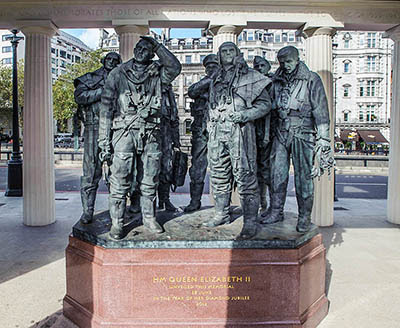A Lancaster Crew
 |
| Source: https://legionmagazine.com/en/2018/02/mystery-of-the-lucky-lancaster/ |
The Lancaster required a crew of seven: The pilot, the engineer, a navigator, a wireless operator, an air bomber and two gunners - one positioned in the mid-upper turret and the other positioned in the tail. The Imperial War Museum describes the roles:
Pilot
The pilot flew the aircraft throughout the operation and coordinated the actions of the other crew members. He was the captain of the aircraft regardless of his rank (in relation to other crew members). He was responsible for the lives of all the crew and the aircraft whilst in the air. If an emergency evacuation of the aircraft was necessary, the pilot had to stay at the controls and be the last to leave.
Engineer
The role of flight engineer was introduced in 1942 as the new heavy bombers required seven-man crews. The flight engineer controlled the aircraft's mechanical, hydraulic, electrical and fuel systems. He also assisted the pilot with take-off and landing. In an emergency, the flight engineer would also be needed to give accurate fuel calculations. He was also the reserve bomb aimer and helped to look out for enemy fighters. On the ground, he also liaised with the ground crew, who were responsible for servicing and maintaining the aircraft.
Navigator
The navigator was responsible for keeping the aircraft on course at all times, reaching the target and then the home base which required a high level of concentration for what could be many hours. Until 1942, the navigator was also responsible for aiming and releasing the bombs.
Wireless Operator
The wireless operator transmitted all messages to and from the aircraft to their base. He had fewer duties than the other crew members as operations were generally conducted in wireless silence. However, he also served as the reserve gunner and addressed any minor emergencies in any part of the aircraft. If the aircraft got into difficulties he had to send out positional signals. If the aircraft had to ditch into the sea, he had to remain at his post to send out a distress signal to improve the crew's chance of being located and rescued.
Air Bomber
The role of air bomber was also introduced in 1942. The bomb-aimer took control of the aircraft when it was on its bombing run. The air bomber would lie flat in the nose of the aircraft, directing the pilot until the bombs were released and the bombing photograph was taken. The photograph was the proof that the operation had been completed, which meant the crew could count it towards their total number of operations carried out. The bomb-aimer could act as a reserve pilot in an emergency as he would have received some flying training.
Mid-Upper Air Gunner
Mid-upper air gunners were physically separated from the other crew members, and would be confined to his turret for the whole flight. Their main duty was to advise the pilot of enemy aircraft movements to allow him to take evasive action and to defend the aircraft against enemy fighters.
Rear Air Gunner
The rear air gunner was further separated from the rest of the crew in the rear turret. The rear gunner’s main duty was to advise the pilot of enemy aircraft, allowing the pilot to take evasive action.
Rear Air Gunner Sergeant Bob Pearson described the conditions in the rear turret: “We would be flying at 250 mph and the wind tore through the clear view panel in the turret – the piece of Perspex that had been removed from the turret canopy to improve vision. My face was exposed to the slipstream – the temperature of which plummeted the higher we went – but it was better to freeze than not to see the enemy. Some rear gunners greased their cheeks with lanolin to ward off the effects; we were often exposed to temperatures of minus thirty or minus forty degrees… We had electrically heated flying suits if we wanted to use them. It plugged into the aircraft like an electric blanket but it was a mixed blessing and I never used mine. It had no thermostat and would never remain at a steady temperature. The danger was that it would get too hot and send you to sleep.” (https://internationalbcc.co.uk/memories/a-rear-gunners-story-tail-end-charlie/)

Comments
Post a Comment